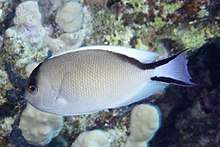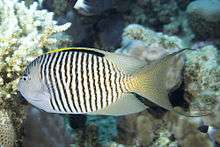Genicanthus caudovittatus
Genicanthus caudovittatus, common names zebra angelfish, swallowtail angelfish, and lyretail angelfish,[1] is a species of marine fish in the family Pomacanthidae.[2]
| Genicanthus caudovittatus | |
|---|---|
 | |
| Female specimen | |
| Scientific classification | |
| Kingdom: | Animalia |
| Phylum: | Chordata |
| Class: | Actinopterygii |
| Order: | Perciformes |
| Family: | Pomacanthidae |
| Genus: | Genicanthus |
| Species: | G. caudovittatus |
| Binomial name | |
| Genicanthus caudovittatus (Günther, 1860) | |
| Synonyms | |
|
Centropyge caudovittatus (Günther, 1860) | |
Description

Genicanthus caudovittatus grows to a maximum length of 20 cm.[3] The caudal fin tips are long compared to similar species.[3]
Distribution
This species is widely distributed and found in the western part of the Indian Ocean from the Red Sea in the north, down to KwaZulu-Natal in South Africa in the south. It is also found in the waters of Madagascar, the Maldives, Mauritius and Réunion, and is also known in Weh Island (northwestern Sumatra).[1]
It is native to the following countries:[1]
- Djibouti
- Egypt
- Eritrea
- Indonesia
- Israel
- Jordan
- Kenya
- Madagascar
- Maldives
- Mauritius
- Mayotte
- Mozambique
- Réunion
- Saudi Arabia
- Somalia
- South Africa
- Sri Lanka
- Sudan
- Tanzania
- United Republic of Yemen
Habitat
This species lives mainly on reefs and steep slopes at depths of between 2 and 70 metres. In the Red Sea, it prefers shallower waters, but in the Andaman Sea, it occurs in waters of 40 metres or greater.[1][3]
Genicanthus caudovittatus is occasionally found in the tropical aquarium trade.[1]
Behaviour
This species does not migrate.[3] Normally, several females will group together with one male.[3]
Diet
Genicanthus caudovittatus eats plankton, normally feeding a few metres above the sea bottom.[3]
References
- "Genicanthus caudovittatus". IUCN Red List of Threatened Species. Retrieved 8 January 2015.
- "WoRMS - World Register of Marine Species - Genicanthus caudovittatus (Günther, 1860)". Retrieved 8 January 2015.
- "Genicanthus caudovittatus, Zebra angelfish : aquarium". FishBase. Retrieved 8 January 2015.
External links
- Photos of Genicanthus caudovittatus on Sealife Collection
| Wikimedia Commons has media related to Genicanthus caudovittatus. |
